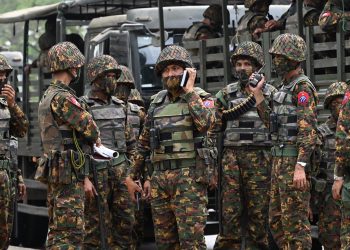Soon after the first Japanese planes strafed Yangon in December 1941, Theippan Maung Wa, like other residents of the colonial capital, grew gloomily accustomed to the frequent sound of warning sirens and the subsequent dash to underground bomb shelters.
A distinguished writer who also worked for the civil service from 1929, Theippan Maung Wa kept a diary from January 1942 until his death some six months later.
“It’s only when there’s a good moon that they come and drop their bombs,” he wrote on Jan. 6. “Bright moonlight used to be something to be happy about, but not now.”
The writer, who evidently did not view the Japanese as would-be liberators, foresaw but could not avoid the violence and disorder that would grip the country.
He was murdered by bandits near Kanbalu in Sagaing Region in June 1942, only two months after writing, with eerie prescience: “In this present crisis, what everybody is afraid of is not so much the Japanese enemy, as the criminals among our own people.”
The Japanese invasion, undertaken with the symbolic assistance of Aung San’s “Thirty Comrades” who would form the nucleus of the Burma Independence Army, did not immediately herald the country’s much-hoped for independence.
Instead, Myanmar was dragged inexorably into the Second World War, becoming, as the academic Donald Seekins put it, “like grass trampled by fighting elephants.”
Hundreds of thousands of Japanese troops and Allied forces drawn from regions as diverse as Nigeria and Nepal, Canada and China, fought in Myanmar’s cities and towns, on the dry open plains, along mountaintops and in thick jungle.
But while military and political leaders pored over strategy and geopolitical objectives, ordinary citizens, caught in a cycle of invasion, occupation and invasion, were more focused on the daily necessities of survival.
Daw Khin Myo Chit, a prominent writer who was scathing of the Japanese interlude, wrote in “The 13-Carat Diamond” of a promising family life that was shattered by the war.
“We found ourselves without a home, without jobs, in fact without anything except a mischievous toddler who was always hungry […] We were lost in the great maze of wartime life.”
Retreat
When Allied forces reclaimed Yangon from the Japanese, 70 years ago this month, it was not the fierce and bloody battle they might have expected.
Against Tokyo’s orders, Japanese commander Heitaro Kimura—who would later be hung as a war criminal by the victorious Allied powers—ordered the evacuation of the bombed and battered city on April 23, 1945.
Among the first to know were the hundreds of Allied prisoners of war in Yangon Central Jail who found a handwritten note left by their Japanese captors at the compound’s main gate.
“[W]e hereby give you liberty […] to leave this place at your own will,” it read in part. “We shall continue our war effort eternally in order to get the emancipation of all Asiatic races.”
Opting to remain within the relative security of the prison walls but wary of “friendly fire,” the POWs painted the messages “JAPS GONE” and “EXTRACT DIGIT” (wartime slang for “hurry up”) in large white letters on the jail’s roof.
Among the convoy of troops and officials that fled to Mawlamyine via Bago, shadowed by Allied bombers throughout the two-week journey, was the head of the Japanese-backed puppet government Dr. Ba Maw and the country’s future prime minister U Nu.
In his memoirs, Dr. Ba Maw—who would eventually escape to Japan where he lived in a Buddhist monastery before being briefly imprisoned by the Allies—claimed to have played a role in dissuading the Japanese hierarchy from defending Yangon to the last, including a plan to turn the Shwedagon Pagoda hill into a militarized defensive post.
‘Operation Dracula’
When first devised by the supreme Allied commander in Southeast Asia Lord Louis Mountbatten in mid-1944, the plan for an air and amphibious attack on Yangon before the next year’s monsoon season appeared ambitious.
However, major Allied gains in central Myanmar under Lt.-Gen. William Slim—the same commander who had overseen the British withdrawal in 1942—meant the Yangon offensive, codenamed “Operation Dracula,” could swing into action.
The huge invasion force that assembled near the mouth of Yangon River, including aircraft carriers, cruisers, destroyers and battleships, would make the largely unimpeded offensive appear almost anticlimactic.
With a battalion of Gurkha paratroopers sent ahead of the main force on May 1, Allied troops began landing along opposing banks of the river the following day.
By May 3, more than three years since it had fallen to the Japanese, the country’s colonial and commercial center had been reoccupied.
Although the city was spared the worst excesses of the war, much of its infrastructure lay in tatters. Major structures including the port, the central railway station and buildings of Yangon University were damaged or destroyed.
Historical photographs show the city’s devastated dockside strewn with rubble and twisted metal. Piles of rice sat rotting on the wharves and now useless Japanese-issued currency was scattered on the streets.
The retaking of Yangon may not loom large in the collective memory of its residents today, but various sites and structures—reconstructed, absent or neglected—evoke the period when the city stood at the crossroads of conflict, colonialism and independence.
The Botahtaung Pagoda, destroyed by a misguided allied air raid in November 1943, was rebuilt and today attracts worshippers of a spirit shrine dedicated to the woman who led its restoration.
The city’s central railway station, the largest in the country, was also rebuilt while the Yangon Central Jail, with its long prison wings arranged like the spokes of a wheel in the same architectural model as the notorious Insein Prison, has since been demolished.
Many of the former capital’s colonial edifices—including the famed Secretariat building that Theippan Maung Wa worked in before the war—while scarred, remain intact.
While Operation Dracula’s success did not signal the immediate end of the war in Myanmar, the Japanese occupation was effectively broken. But although the British were back and claiming, according to Lt.-Gen. Slim, that their return was welcomed “almost without exception,” the colonial project was terminal.
This article first appeared in the May 2015 edition of The Irrawaddy magazine.























